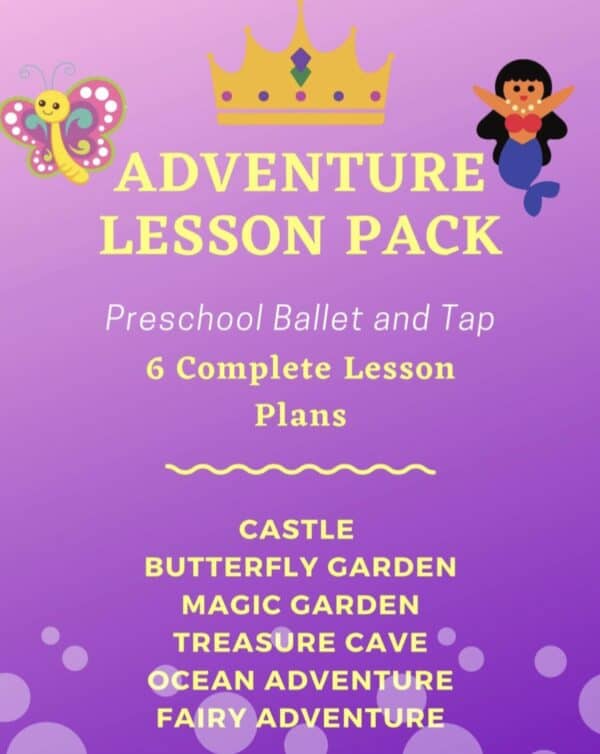
Tiny Dancers Class: 3 Awesome Tips to Inspiring Quick Order
Whether you’re facing a brand new class of littles or you are walking in to greet the same group you’ve had for months, law and order in the classroom is key. It’s important because a bunch of cute ballerinas in sparkly black leotards and pink tights can turn into a band of mini elephants faster than you can say ‘grand battement.’ Keeping a tiny dancers ballet and tap class orderly can be a challenge.
I don’t know about you, but I personally go a little nuts when baby, preschool, and kindergarten dancers are running loose. It’s not necessary for littles instructors need to tolerate unbridled disorganization or noise. I remember one time after I taught, the front desk receptionist at the studio said “We were watching your class the other day and were wondering how on earth you get them all to sit on their dots like that. Generally it’s something of a free-for-all.”
Well, it doesn’t have to be! Establishing law and order even with the teeniest of tots makes class more enjoyable for everyone and will save you from a terminally sore throat. Yes, please.
Let’s discuss a few ways to keep in a room full of eager preschool and kinder dancers organized.
Establish Structure

Every teacher knows the value of structure in a tiny dancers ballet and tap class. The art form requires it at any level. But how do you encourage littles to embrace this aspect of dancing?
One word: routine.
Without routine classes can get chaotic fast.
I have found that if my students have an idea what is coming, they tend not to lose focus between exercises. Just to give you an idea, here is the setup I generally follow with my students ages 3-6:
- Circle time: A circle made by dots in the center of the room for babies. They have fun choosing their color and where they want to sit which already makes this feel like a “non-rule.” For older dancers I have them sit on the dance line that is compliments of the Marley.
- Barre or around the room: After a fun activity, we either go to the barre or do a fun, around-the-room activity depending on their age.
- Line across the back of the room: I do across-the-floor next so I have them all sit against the back wall in an orderly line with their dots if needed.
Tip For Managing Tiny Dancers Class
If I am having the littles in my tiny dancers class their dots with them, I have them place their dot on their head while still in the circle, providing an orderly and simplistic way for my assistant or I to direct them to their new spots against the wall. I’ll usually keep them in this formation for the tap portion of class because it is easy for them to return to their spots after changing their shoes.
- Staggered lines: This is the next formation I use for tap class. This is usually when we do some sort of follow-along activity.
- Free-flowing: Find their own spot in the room for freeze-dance or some other form of follow-along big finish.
Looking for fresh new choreographies, exercises, music, and games for your littles classes? Check out the Adventure Lesson Pack now only $17! You’ll want to use these 6 complete lesson plans over and over.
Noise Control
We all know how quickly the volume can get out of control. There are many different methods when it comes to getting the class to quiet down. Let me share one verbal and one action method I use to keep the sound of enthusiastic dancers manageable.

- Verbal: There are lots of common verbal requests for silence amongst teachers. One, two, three, eyes on me. Clap twice if you can hear me. The list goes on. My personal favorite is “marshmallows in.” The kids love pretending to “eat” their marshmallows and it effectively gets everyone quiet long enough for me to recapture their focus.
- Transitions cue: Imagination and storytelling has always played a prominent role in my class structure. I’ve found that it’s during transitions or lulls that things tend to get noisy. The switch from ballet to tap shoes especially so. For this reason, I began implementing the rule that tap shoes must remain quiet unless we’re doing an exercise. If not, the evil step-mother, dragon (you fill in the blank) will find us. It works like a charm and the kiddos are so proud when they get to their spot soundlessly after putting on their shoes.
- Barre etiquette cue: Introducing small dancers to the barre and how to handle it is vital as it plays such a huge role in the art form. We all know what it’s like to have littles swinging from the barres like baby monkeys. I teach respect early by explaining that the barre needs to be treated with care and respect. One of my littles likened it to the glass rose in Beauty and the Beast. It’s my favorite metaphor yet.
Be Honest

They say that honesty is the best policy. I’ve found this to be true in life as well as in the classroom. When establishing respect for the artform, order is a fortunate byproduct. I always take the opportunity to explain to the littles that listening ears are super important so that we can learn all the things we need to in order to have a ton of fun. The benefits of being honest about this are twofold:
- It provides the opportunity to set ground rules in a clear and inescapable way
- It gently introduces the littles to the concept of discipline leading to remarkable rewards.
We as teachers want nothing more than to provide a great experience to our students. If we are going to be effective in sharing our art form, law and order is necessary. I hope these tips were helpful! Feel free to share your own methods for keeping order in your tiny dancers class in the comments. I would love to hear!
Want more great ideas for little dancers class? Check out Preschool Ballet and Tap: A Guide for Teaching Successful Classes
More Content to Love







2 Comments
Arianna
Thank you for all of the tips which are perfect for going into my Fall season next week 🤗
A method I use to quickly get little dancer’s attention if they’re all talking at once is saying “if you’re listening touch your nose!” And then I continue with “touch your cheek, touch your chin, touch your cheek again” and so on until they’re all focused again.
To smooth out transitions I like to give every dancer a job to help clean up the room. I use pieces of tape, hula hoops and blocks etc for obstacle courses so when it’s time for the next activity I direct each dancer to which item they’re going to pick up so we can tidy up the classroom. If there are more dancers than items I give the remaining dancers the special job of helping prepare us for dance party by passing out scarves or turning the lights off when it’s time.
Good luck to all of the dance teachers starting classes next week! 🥰
Sierra Mullins
I love these ideas! Love the clean-up helper idea. Teaching responsibility and getting the job done at the same time. Perfect 😀